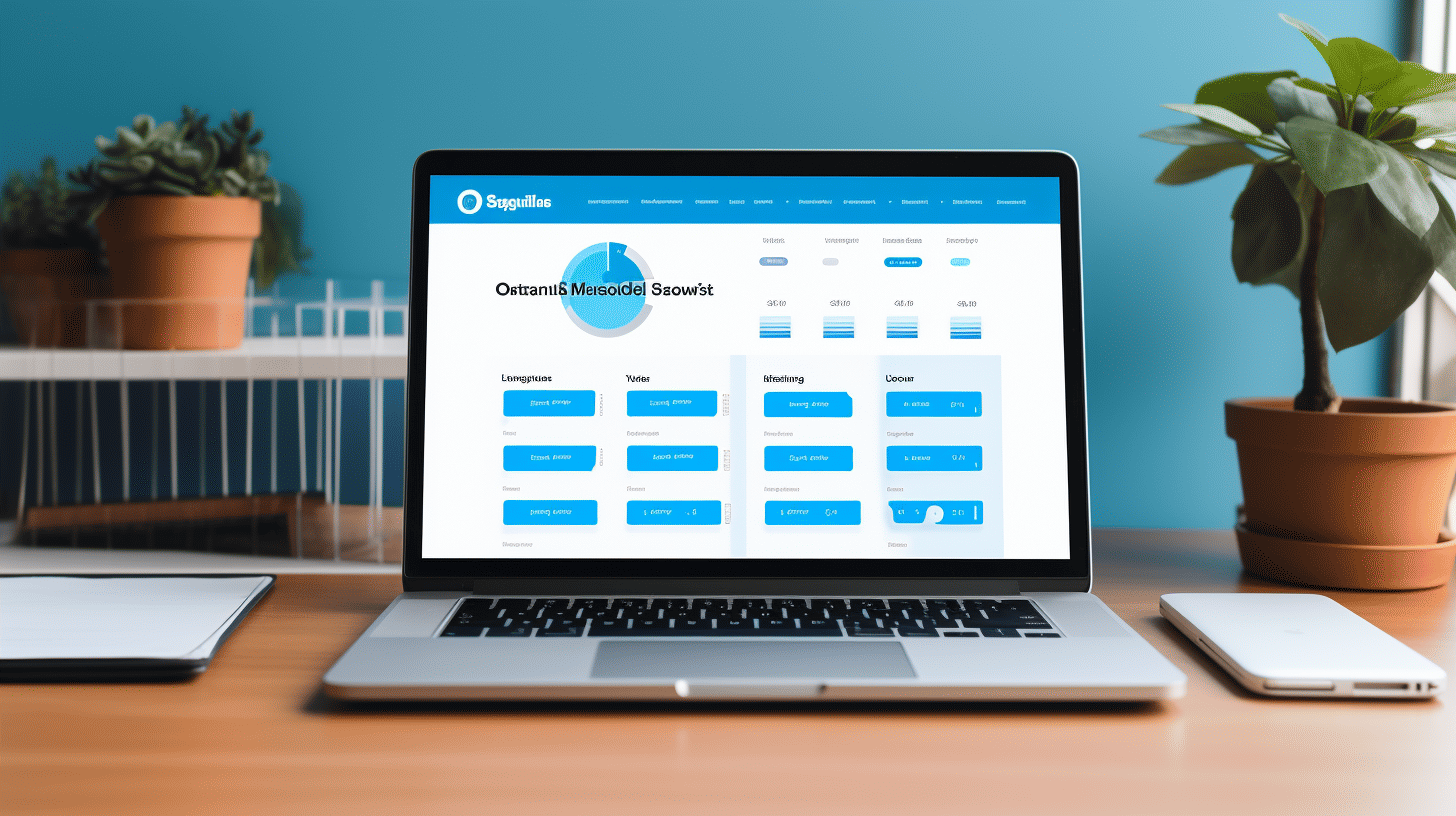在当今的数字时代,拥有强大的在线形象不再只是一种选择,而是小型企业的必需品。精心设计的网站可以成为吸引和吸引客户、展示产品或服务并最终推动增长的强大工具。随着众多网站建设平台的出现,WordPress 已成为希望建立在线形象的小型企业主的首选。
🌟 为什么选择 WordPress? 🌟
WordPress 是一款功能多样且用户友好的内容管理系统 (CMS),企业主无需具备丰富的编码技能即可创建和维护自己的网站。其直观的界面和丰富的主题和插件库使其成为小型企业的理想选择,使他们能够创建专业且具有视觉吸引力的网站,有效地代表他们的品牌。
无论您是个体经营者、本地服务提供商还是电子商务企业,WordPress 都提供可扩展且灵活的平台,可满足您的特定需求。借助其强大的功能和广泛的自定义选项,您可以创建一个不仅外观精美而且运行顺畅并提供无缝用户体验的网站。
但仅仅拥有一个网站是不够的。要想在竞争激烈的在线市场中真正脱颖而出并取得成功,小型企业需要做的不仅仅是创建一个网站。他们必须专注于提高用户参与度、针对搜索引擎优化网站,并采取适当措施维护网站的安全性和性能。
在本文中,我们将探讨在线形象对于小型企业的重要性,并提供有价值的提示和见解,以帮助您创建、优化和维护专业的 WordPress 网站。无论您是刚起步还是希望改造现有的在线形象,本文都将作为全面的指南,帮助您驾驭 WordPress 世界并将您的小型企业推向新的高度。
那么,让我们深入研究并释放 WordPress 为您的小型企业带来的强大力量!
网络影响力对小企业的重要性
在当今的数字时代,建立强大的在线形象对于小型企业的成功至关重要。随着越来越多的消费者转向互联网来研究和购买产品或服务,拥有强大的在线形象可以为小型企业提供竞争优势并打开新的机会之门。
竞争优势
根据最近的统计数据, 73% 小型企业 已有网站[1]。这些企业了解在线展示其产品或服务以吸引更多受众的重要性。相比之下, 美国 28% 的小型企业没有网站[2]。这群企业正在错失与潜在客户建立联系和树立品牌信誉的重要机会。
拥有网站可以让小企业:
- 覆盖更广泛的受众:网站就像一个虚拟店面,任何有互联网连接的人都可以访问。它使小型企业能够将业务范围扩大到本地以外,并进入全球市场。
- 建立品牌信誉:专业的网站能给潜在客户留下深刻的第一印象,并赢得他们的信任。它让企业能够展示他们的专业知识、推荐和产品组合,从而在消费者眼中树立信誉。
- 增强客户参与度:精心设计的网站为客户提供了一个与企业互动、提出问题和咨询的平台。它能够提供更好的客户服务和个性化体验,最终提高客户满意度和忠诚度。
网站服务市场不断增长
随着对在线业务的需求不断增长,网站服务市场经历了显着增长。小型企业在创建和管理网站方面现在拥有广泛的选择。像 WordPress 这样的平台因其用户友好的界面和广泛的自定义选项而成为热门选择。
为了建立成功的在线形象,小型企业可以利用 WordPress 的强大功能来:
- 创建具有视觉吸引力的网站:WordPress 提供了大量的主题和模板,使企业无需任何编码知识即可创建令人惊叹、专业的网站。
- 针对搜索引擎进行优化:WordPress 提供内置的 SEO 工具和插件,帮助企业针对搜索引擎优化其网站。这可确保其网站在搜索结果中排名更高,提高知名度并推动自然流量。
- 整合电子商务功能:随着网上购物的日益普及,小型企业必须接受电子商务。WordPress 提供各种插件和集成,使企业能够无缝建立在线商店并接受付款。
需要更多采用电子商务
虽然拥有网站至关重要,但小型企业也应该采用电子商务,以在当今市场保持竞争力。COVID-19 疫情加速了向网上购物的转变,企业必须适应并满足不断变化的消费者需求。
统计数据显示 44% 的企业没有网站 计划在 2021 年创建一个[3]。这凸显了小企业越来越意识到建立在线业务的必要性。此外, 拥有网站的小型企业占 83% 相信自己比没有竞争优势的人有竞争优势[4]。这些企业明白,采用电子商务是现代市场生存和发展的关键。
通过将电子商务功能整合到其网站中,小型企业可以:
- 扩大客户群:电子商务使企业能够向其实际所在地以外的客户销售产品,从而接触到更大的潜在买家群体。
- 增加收入:网上销售有可能为企业带来巨大的收入来源。电子商务消除了地域限制,全天候运营,让企业即使在实体店关门的情况下也能创造销售额。
- 为顾客提供便利:网上购物的便利性,包括便捷导航、产品比较和安全支付选项等功能,提升了整体客户体验。这反过来又提高了客户满意度和回头客数量。
总之,在当今竞争激烈的环境中,拥有强大的在线形象对于小型企业的蓬勃发展至关重要。通过采用网站和电子商务技术,企业可以接触到更广泛的受众,建立信誉,并挖掘新的收入来源。借助 WordPress 等平台,小型企业可以更轻松地打造成功的在线形象。
为小型企业创建 WordPress 网站
欢迎来到 WordPress 的世界!如果您是希望建立强大的在线形象的小型企业主,那么您来对地方了。使用 WordPress,您可以轻松创建专业且引人入胜的网站,而无需大量的编码知识。在本文中,我们将指导您为您的小型企业建立自己的 WordPress 网站的过程。
了解 WordPress
在进入激动人心的网站创建世界之前,重要的是要对 WordPress 是什么以及它如何工作有一个基本的了解。WordPress 是一个流行的内容管理系统 (CMS),它允许用户轻松构建和管理网站。它为互联网上超过 40% 的网站提供支持,使其成为各种规模企业的首选平台。
首先,请访问我们的 了解 WordPress 指南可帮助您熟悉 WordPress 的核心概念和功能。这将帮助您自信地浏览本文的其余部分并充分利用 WordPress 平台。
选择主题
一旦你对 WordPress 有了充分的了解,就该为你的小型企业网站选择一个主题了。主题决定了你网站的整体外观和感觉,因此选择一个与你的品牌和业务目标相符的主题很重要。以下是选择主题时需要记住的一些提示:
- 响应式设计:选择响应式主题,这意味着它可以适应不同的屏幕尺寸,并且在桌面和移动设备上都看起来很棒。这对于为您的网站访问者提供积极的用户体验至关重要。
- 定制选项:寻找提供各种自定义选项的主题,例如配色方案、布局选项和字体选择。这将允许您定制您的网站以匹配您的品牌并使其真正独一无二。
- 用户评论:查看您感兴趣的主题的评论和评分。这将让您了解其质量和可靠性,帮助您做出明智的决定。
定制
选择主题后,就可以对其进行自定义,以适应小型企业的品牌和风格。自定义过程可能因您选择的主题而异,但以下是您应该了解的一些常见自定义选项:
- 标识:上传您的企业徽标,让您的网站更具专业感。大多数主题允许您在标题区域内轻松添加和定位您的徽标。
- 配色方案:自定义网站颜色以匹配您的品牌。这通常可以通过 WordPress 定制器中的简单颜色选择器工具来完成。
- 字体:选择能够反映您品牌个性的字体,让您的内容易于阅读。许多主题都提供多种字体选项供您选择。
添加基本业务信息
接下来,是时候向您的网站添加必要的业务信息了。这包括联系方式、营业时间以及您的产品或服务的简要说明。以下是您应该包含的关键元素的清单:
- 联系信息:在您的网站上突出显示您的公司电话号码、电子邮件地址和实际地址。这可让潜在客户轻松与您取得联系。
- 关于我们:制作一个引人注目的“关于我们”页面,讲述您的业务、使命和价值观。这有助于与受众建立信任和个人联系。
- 服务/产品:创建专门的页面来展示您的产品或服务。提供详细的描述和高质量的图片来吸引潜在客户。
创建吸引人的主页
主页通常是访客对网站的第一印象,因此,让主页引人入胜、引人入胜非常重要。以下是创建吸引人眼球的主页的一些技巧:
- 清晰简洁的信息:在主页上清晰简洁地传达您企业的独特销售主张 (USP)。使用引人注目的文案和视觉效果来吸引访客的兴趣。
- 号召性用语按钮:包括突出的号召性用语按钮,鼓励访问者采取所需的操作,例如“联系我们”或“立即购买”。
- 推荐/评论:展示满意客户的积极推荐或评论,以建立信任和信誉。
安装必要的插件
最后,是时候通过安装必要的插件来增强小型企业网站的功能了。插件就像应用程序一样,可以扩展 WordPress 网站的功能和性能。以下是每个小型企业网站都应考虑的一些基本插件:
- 联系表单插件:安装联系表单插件,方便访客与您联系。热门选项包括 Contact Form 7 和 WPForms。
- 搜索引擎插件:通过安装 Yoast SEO 或 Rank Math 等 SEO 插件来提高您网站在搜索引擎中的可见度。这些插件提供了有价值的功能来优化您的内容以适应搜索引擎。
- 安全插件:安装 Wordfence 或 Sucuri 等安全插件,保护您的网站免受网络威胁。这些插件有助于防止黑客攻击并确保您的网站安全。
总之,为您的小型企业创建 WordPress 网站是一项令人兴奋的事业,它为您打开了一个充满可能性的世界。通过遵循本文概述的步骤,您将顺利建立专业的在线形象,吸引客户并推动业务增长。所以,让我们立即开始构建您的 WordPress 网站吧!🚀
利用 CTA 增强用户参与度
您是否知道 70% 的小型企业在其网站主页上没有 CTA(行动号召)?考虑到 CTA 对于推动用户参与和转化的重要性,这是一个令人惊讶的统计数据。CTA 是鼓励访问者在您的网站上采取特定操作的提示,例如注册新闻通讯、进行购买或下载免费资源。
但是,为什么 CTA 如此重要?因为它们是访客的指南,引导他们在您的网站上进行下一步。如果没有明确的 CTA,访客可能会感到迷茫或不确定要采取什么行动。位置合适且引人注目的 CTA 可以对您网站的用户参与度指标产生重大影响,例如点击率、转化率和总体用户满意度。
以下是为什么采用有效的 CTA 对增强网站用户参与度至关重要的一些原因:
- 明确方向: CTA 为访客提供明确的方向,引导他们采取所需的行动。它消除了困惑,并帮助用户了解下一步需要做什么。
- 增加转化次数: 精心设计的 CTA 是提高网站转化率的强大工具。如果位置和措辞得当,它们可以吸引用户采取行动并完成预期目标,例如进行购买或填写联系表格。
- 改善用户体验: 用户友好的网站引人入胜,浏览起来令人愉悦。CTA 在改善用户体验方面发挥着至关重要的作用,它使访问者更容易找到信息或执行他们访问您网站的任务。
- 提高点击率: 引人注目的 CTA 可以显著影响您的点击率。当用户受到强有力的 CTA 激励时,他们更有可能点击所需的链接并进一步探索您的网站。
- 捕获有价值的数据: CTA 可用于从用户那里收集有价值的数据,例如用于订阅新闻通讯的电子邮件地址或个性化推荐的偏好。这些数据可用于定制未来的营销工作并提高用户参与度。
为了有效地将 CTA 纳入您的网站并增强用户参与度,请考虑以下提示:
- 使用鼓励立即采取行动的行动导向语言,例如“立即注册”或“今天开始”。
- 使用对比色和引人注目的设计元素让您的 CTA 具有视觉吸引力。
- 策略性地放置您的 CTA,确保您的访问者可以轻松看到和访问它们。
- 测试 CTA 的不同变体,以查看哪些变体效果最佳,并进行相应优化。
通过在您的网站上实施有效的 CTA,您可以创造更具吸引力的用户体验并提高转化率。不要错过引导访问者采取行动并实现业务目标的机会。立即开始提高用户参与度!
增强用户参与度 使用 CTA。
网站优化
在当今的数字时代,拥有一个经过良好优化的网站对于成功至关重要。网站优化涉及改进网站的各个方面,以提高其性能、可见性和用户体验。从速度和性能到 SEO 和移动优化,在优化网站时需要牢记几个关键注意事项。
速度和性能
网站速度和性能对用户满意度和整体成功起着重要作用。加载缓慢的网站会导致高跳出率,并阻止访问者进一步探索。以下是优化网站速度和性能时需要关注的一些重要因素:
- 页面加载时间:尽量缩短加载时间,以吸引访客。研究表明,如果网站加载时间超过 3 秒,40% 的访客将放弃该网站。
- 缓存:利用缓存技术存储经常访问的网站数据,减少回访者的加载时间。
- 图像优化:在不影响质量的情况下压缩图像以减小文件大小并缩短加载时间。
- 最小化代码:缩小 JavaScript、CSS 和 HTML 文件可以简化您网站的代码并减少加载时间。
提高网站的速度和性能不仅对用户有利,而且对搜索引擎排名也有积极影响。Google 等搜索引擎会优先考虑加载速度快的网站,从而提高其在搜索结果中的可见度。
SEO(搜索引擎优化)
SEO 是网站优化的基本组成部分。它涉及优化网站的内容、结构和其他元素,以便在搜索引擎结果页面 (SERP) 中排名更高。以下是一些需要考虑的关键 SEO 策略:
- 关键词研究:确定人们在搜索与您的产品或服务类似的产品时使用的相关关键字和短语。将这些关键字策略性地融入您的网站内容中。
- 元标签:制作引人注目的元标题和描述,准确描述您网站每个页面的内容。元标记可作为搜索结果中的预览,并可影响点击率。
- 优质内容:创建高质量、信息丰富且引人入胜的内容,以满足目标受众的兴趣和需求。通过提供有价值的内容,您可以吸引更多访问者并鼓励他们留在您的网站上。
- 反向链接:从信誉良好的网站获取反向链接,因为它们是信任和权威的标志。建立强大的反向链接配置文件可以提高您网站的可信度和在搜索结果中的可见性。
移动优化
由于大多数互联网用户都通过移动设备访问网站,因此针对移动设备优化网站已不再是一种选择,而是一种必需。以下是针对移动设备优化的一些基本注意事项:
- 响应式设计:确保您的网站具有响应能力,这意味着它可以适应不同的屏幕尺寸和分辨率。这可确保移动用户获得无缝体验。
- 适合移动设备的内容:创建易于在移动设备上阅读和浏览的内容。使用清晰的字体大小,避免使用可能妨碍用户视线的弹出窗口或插页式广告。
- 页面速度:移动用户希望网站加载速度快。优化您的网站在移动设备上的加载速度,以提供流畅的浏览体验。
您是否知道 85% 的成年人认为公司的移动网站应该与其桌面网站一样好甚至更好?在当今移动优先的世界中,不要忽视移动优化的重要性。
优化网站是一个持续的过程,需要定期更新和维护。通过实施正确的速度和性能、SEO 和移动优化策略,您可以创建一个不仅能吸引访客,还能让他们保持参与度和满意度的网站。
详细了解 掌握网站性能 将您的网站优化游戏提升到新的水平。
维护你的 WordPress 网站
👋 欢迎来到 WordPress 网站维护的世界!在本文中,我们将探讨三个关键方面,它们将帮助您保持 WordPress 网站顺利运行:定期更新、安全措施和备份。无论您是经验丰富的 WordPress 用户还是刚刚开始使用,这些维护任务对于您网站的整体健康和性能都至关重要。
定期更新
出于多种原因,保持 WordPress 网站及其组件的更新至关重要。更新不仅为您提供最新的功能和增强功能,还可以提高网站的安全性和稳定性。以下是定期更新时需要关注的几个关键领域:
- WordPress 核心更新: 定期检查并安装 WordPress 核心软件本身的更新。这些更新通常包括错误修复、性能改进和安全补丁。
- 主题更新: 如果您使用的是 WordPress 主题,请务必定期更新。主题更新通常会解决错误、兼容性问题,甚至引入新功能以增强网站的设计和功能。
- 插件更新: 插件在扩展 WordPress 网站的功能方面起着至关重要的作用。请始终留意插件更新并及时安装。插件更新不仅可以添加新功能,还可以修复可能发现的任何问题或漏洞。
请记住在进行任何更新之前备份您的网站,以防更新过程中出现问题。
安全措施
确保 WordPress 网站安全是重中之重。随着网络威胁和攻击的增多,实施必要的安全措施来保护您的网站及其宝贵数据至关重要。以下是一些需要考虑的关键安全措施:
- 强密码: 确保 WordPress 网站上的所有用户帐户都拥有强大且独特的密码。强大的密码包括大小写字母、数字和符号的混合。
- 安全托管: 为您的 WordPress 网站选择一家信誉良好且安全的托管服务提供商。寻找提供防火墙、恶意软件扫描和定期备份等功能的提供商。
- SSL 证书: 为您的网站安装 SSL 证书,以实现安全浏览并保护登录凭据和用户数据等敏感信息。
- 安全插件: 考虑使用安全插件来增强 WordPress 网站的安全性。这些插件提供恶意软件扫描、暴力破解保护和防火墙功能等功能。
备份
定期备份就像是 WordPress 网站的安全网。它们确保即使发生数据丢失或灾难性事件,您仍拥有一个最新且可正常运行的网站副本,以便进行恢复。以下是您需要了解的有关备份的信息:
- 频率: 根据网站更新频率设置定期备份计划。如果您经常更新网站,请考虑每日或实时备份。
- 异地存储: 将备份存储在安全的异地位置,与 Web 服务器分开。这样可以确保即使您的服务器受到攻击,您的备份仍能保持完整。
- 测试修复: 定期测试备份的恢复过程,以确保其正常运行。此做法可帮助您识别备份文件中的任何问题,并确保在需要时可以恢复它们。
请记住,维护 WordPress 网站是一个持续的过程。通过实施定期更新、安全措施和备份,您将朝着确保网站寿命和成功迈出重要一步。
要探索 WordPress 网站维护的更多基本服务,请查看 WordPress 的基本服务。请继续关注有关维护 WordPress 网站的更多提示和最佳实践!👍
结论
总之,对于希望建立强大的在线形象的小型企业主来说,创建和维护专业的 WordPress 网站至关重要。通过利用 WordPress 的强大功能,企业可以自定义其网站以反映其品牌身份,通过引人入胜的主页设计和引人注目的号召性用语 (CTA) 与用户互动,并优化其网站的速度、性能和移动设备。
为了确保访客获得无缝的网站体验,务必定期更新、实施强大的安全措施并备份您的 WordPress 网站。这些步骤将有助于降低安全漏洞的风险,并确保您的网站始终具备最新功能和安全补丁。
Managed-WP™ 是一款高级托管 WordPress 云托管平台,能够为小型企业主提供支持。凭借其简化的基础设施、自由的数字体验以及 24/7/365 全天候提供的专业问题解决方案,Managed-WP™ 为小型企业提供了创建和维护专业 WordPress 网站所需的安心和支持。
迈向强大在线形象的第一步是访问 托管-WP.com 并探索可用的高级托管 WordPress 托管选项。借助 Managed-WP™,您可以专注于发展业务,同时将网站管理的技术方面交给有能力的人。
常见问题
- 为小企业主创建专业的 WordPress 网站有哪些技巧?
为小企业主创建专业的 WordPress 网站的一些技巧包括:选择简洁专业的主题、使用品牌元素定制您的网站、优化网站速度和性能、添加高质量的图像和内容、整合社交媒体以及定期更新和维护您的网站。
- WordPress 如何帮助小型企业创建专业的网站?
WordPress 提供用户友好的界面、各种可自定义的主题和插件以及强大的 SEO 功能。它允许小型企业主轻松创建和管理他们的网站、专业地展示产品和服务,并通过在线营销策略吸引客户。
- 我需要任何编码知识来创建和维护 WordPress 网站吗?
不,您不需要编码知识即可创建和维护 WordPress 网站。WordPress 提供了可视化编辑器和拖放功能,让初学者可以轻松自定义他们的网站。但是,拥有基本的编码知识对于更高级的自定义很有帮助。
- 如何优化我的 WordPress 网站以获得更好的搜索引擎排名?
为了优化您的 WordPress 网站以获得更好的搜索引擎排名,您可以使用 Yoast SEO 或 Rank Math 等 SEO 插件,使用相关关键字优化您的内容,创建描述性元标记和标题,添加 XML 站点地图,提高网站速度并建立高质量的反向链接。
- 为什么定期更新和维护我的 WordPress 网站很重要?
出于安全、性能和功能方面的考虑,定期更新和维护 WordPress 网站非常重要。更新可确保您的网站免受漏洞攻击、插件和主题兼容,并且您的网站运行顺畅,从而提供积极的用户体验。



















